
Ed Poulter enjoys a weekend of snowy Munros from a base at Corrour bothy, a popular haunt in the heart of the Cairngorms
With the weather finally improving (well, maybe?), daylight on the increase and snow still on the high hills, early spring can be a fabulous time for mountains. Sometimes it pays to think big, and there's nothing bigger than a multi-day trip into the wilds. Spending a night or two out turns a hill walk into a mini expedition. But it doesn't have to mean the discomfort of camping. Mountain bothies can be a welcome refuge from the elements, often being equipped with a multi fuel stove with the potential (if you have carried in the fuel) to radiate copious amounts of heat to stave off the cold, dry gear and act as a focal point around which to swap tales and drink malt.
Spending time in the Highlands in winter is an immensely rewarding experience, and when you're out for a few nights in snow-capped mountains and sub-zero temperatures it can feel like a mini arctic adventure.
Last year's season was a great one. With a decent forecast we siezed the opportuninty for a three-day, two-night trip out to Corrour bothy in the heart of the Cairngorms. It's a great base for some hard-to-reach Munros, putting remote summits into range without having to make a massive single day of it. The bothy is an amazing situation nestled right under the Devils Point and with the River Dee practically flowing outside its front door.
"We met knee deep snow and lovely wind-carved sastrugi, and route finding became difficult. The snow was particularly tiresome with big packs, and we probably should have brought our skis"
We drove up on Friday night after work, just making it over the A93 pass into Braemar because of the snow. The following morning there was a fresh covering of snow outside the hostel. The day dawned clear and cold (-3 showing on the car thermometer) – a great way to start off our mini winter expedition. The road up to the Linn of Dee doesn't get gritted so if it's snowy you'll probably need winter tyres to get you to the parking spot.
We set off from the car with four season sleeping bags and most importantly 10kg of coal in tow, to ensure that we would be toasty warm during the long bothy nights. Walking up Glen Lui you're struck by the snow capped high rolling peaks standing out through interspersed ancient Caledonian forest, so characteristic of this part of the Cairngorms. The track that leads to Derry Lodge is in very good condition and we made good time to the lodge, which is set amongst scots pines. The stream junction where Derry Burn meets Lui Water makes a perfect picnic spot. After crossing the bridge over the Derry Burn we carried on west, fording the Luibeg Burn. From here the path rises and contours around Cain a' Mhaim at around 600m. Here we met knee deep snow and lovely wind-carved sastrugi, and route finding became difficult. The snow was particularly tiresome on the last 4km stretch to the bothy, especially with big packs. We probably should have brought our skis. We arrived at the bothy tired and just after dark with the moon illuminating the frozen landscape, the icy River Dee glistening and the nearby peaks shimmering into the night sky – an unforgettable memory.
"Using a bothy is a great way to meet like minded people. Of course we were not alone at Corrour."
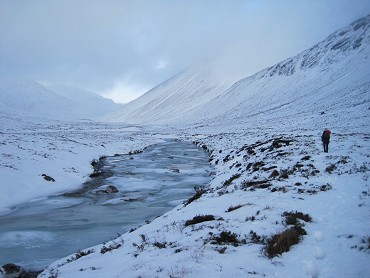
© Ed Poulter |
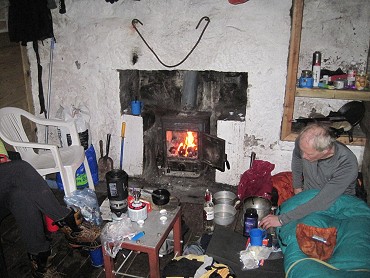
© Ed Poulter |
Corrour bothy is situated 560m above sea level. It is a small bothy, really only comfortable for around six people, though I have heard of double that sleeping in the bothy over busy periods such as New Year and Easter. So at all costs avoid it at these times. On the plus side there's a good multi fuel stove, a raised sleeping shelf which sleeps two and a basic composting toilet (a rare luxury in a bothy). Using a bothy is a great way to meet like minded people. We were not alone at Corrour (no surprise there); the first night we were joined by four students from Aberdeen University and on the second night by a local guy and his dog, Molly, who had walked over from Aviemore through the Lairig Ghru. With the long evenings it was a great opportunity to exchange mountain tales with a wee dram around the fire.

© Ed Poulter |

© Ed Poulter |
When venturing into the mountains at this time of year it can be a bit hit and miss as to what the conditions can be like and this can ultimately affect plans. It pays to stay flexible. Knee deep powder can often make progress laboriously slow and present areas of high avalanche danger, whereas consolidated neve can in fact produce better walking conditions than in summer. For this trip we were faced with powder, and it somewhat limited our options. With a high avalanche risk on some slopes it wouldn't have been easy to find a safe route up onto the Braeriach plateau. Instead we opted for Scotland's second highest, Ben Macdui, and neighbouring No match for crag id:"Carn a'Mhaim".
The route from the bothy to the summit of Ben Macdui is not technical but in winter conditions it requires good crampon technique and basic winter competence. It starts with a gentle walk up the glen before a relentless slog up the shoulder to the south of the Allt Clach nan Taillear. The going gets easier as you get higher and if you're lucky with the weather, the views across the Cairngorms are fantastic – out to Ben Avon in one direction and Cairn Toul and the Devils Point to the other. Once you have bagged the trig point at the summit of Ben Macdui you retrace your steps back down onto the small plateau on the col where the ridge of Carn a' Mhaim begins. From here it's easy walking among the odd knoll along the ridge that takes you to the cairned summit of Carn a' Mhaim. We found the descent straightforward, heading through quite steep angled slopes to hit the path to Corrour that we'd used the previous day.
When we opened the bothy door next morning it was evident that the high pressure of the last few days was coming to an end. The wind was starting to pick up and snow was falling intermittently. With food running low and the coal having being burnt it was time to leave. After the initial powder bashing through the drifted snow we soon made it onto the good tracks of Glen Luibeg and finally back to the car. It's mandatory after a trip like this to stop off in Breamar for a cuppa and cake before hitting the road and the long drive back home.
Looking back now, this really was an adventure that captured the feeling of being 'out there'. From the drifting snow swirling through our legs on the walk in and the icy wind battering our faces as we approached the summit of Ben Macdui, to simply having to melt snow for drinking water, it was a little bit of arctic magic. I hope you get to enjoy a similar adventure.
To summarise, if you're venturing out into this type of terrain in winter you do need to be winter aware – know how to use crampons and an ice axe, have good navigation skills and have some avalanche awareness. You won't be able to download the SAIS avalanche forecast on your smartphone from Glen Dee!
When using mountain bothies it's essential to take your own fuel, unless you're in one that's situated near to the coast where you can source drift wood. Check bothy availability on the Mountain Bothies Association website (MBA - assuming your chosen bothy is one of theirs); take candles and just in case don't forget a bivvy bag for when you turn up late and find the bothy full! And always leave the bothy in better condition than you found it - carry out litter and give it a spring clean.
About Ed Poulter
Yorkshire-based outdoor instructor Ed loves to spend his free time getting out mountaineering, fell running, climbing and caving, meeting all the amazing people that make these sports so much fun. He takes every opportunity he can to get away and explore new places in the UK and further afield, and is currently planning an Indian Himalaya expedition for 2015 into a previously unexplored area.
Ed is also an active member of his local cave and mountain rescue team UWFRA in the Yorkshire Dales.
- Morocco - Trekking The High Atlas 7 Sep, 2012



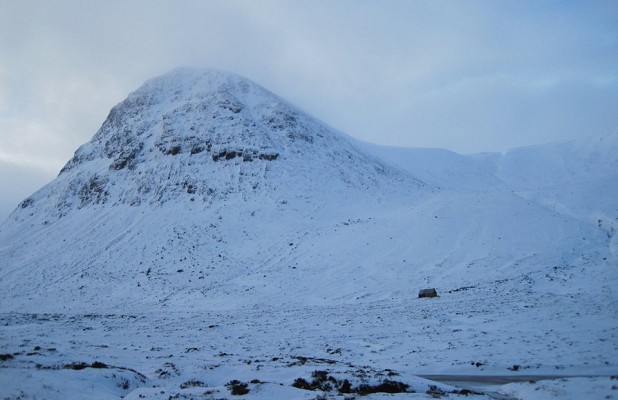
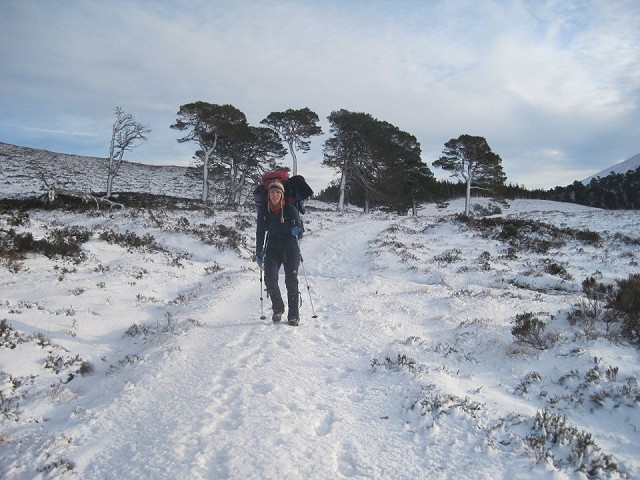
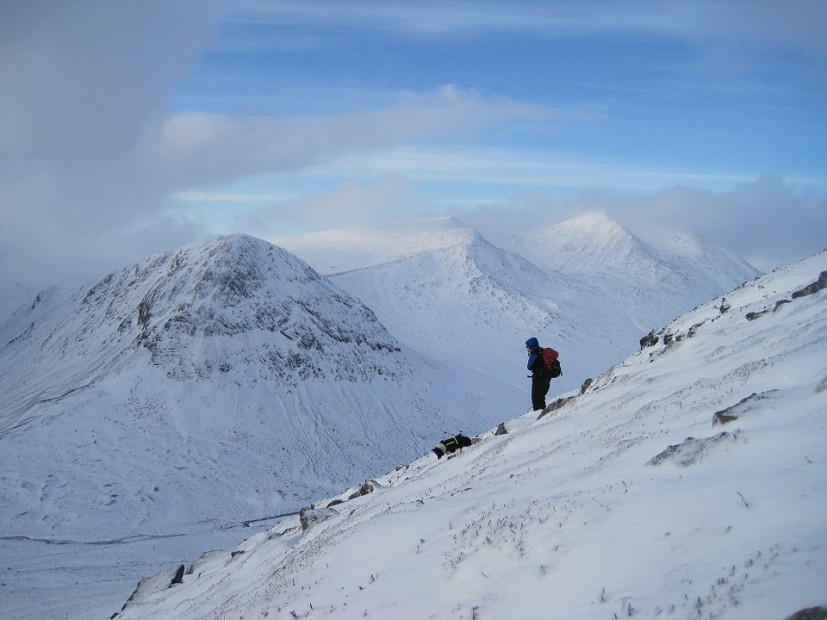
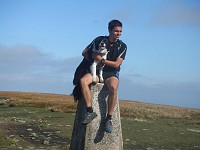

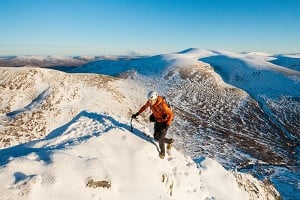
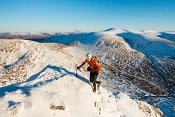





Comments